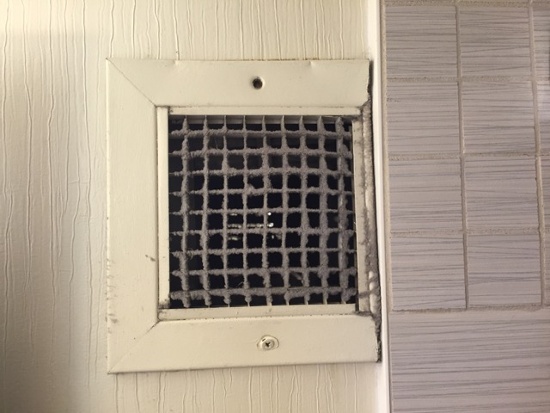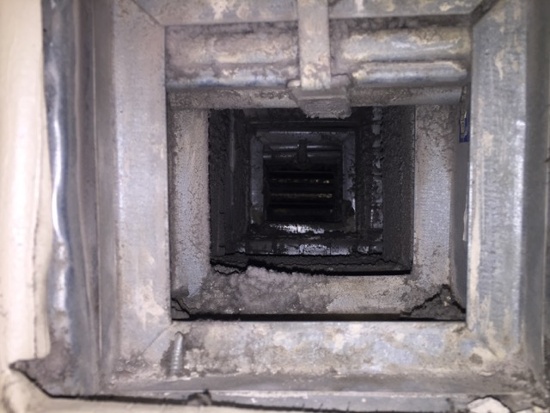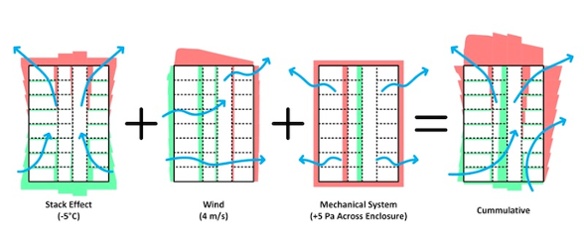Adventures in Hotel Bathroom Ventilation

I always look at the bathroom ventilation when I’m staying in hotels. Last month I was at the Air Barrier Association conference in Baltimore and took the photo above. Can you tell anything about what might be happening by looking at it? I didn’t do a thorough investigation, but here’s what I see.
That’s a lot of air flow
The vent is very dirty. That indicates a lot of air flow. It could be a low flow rate over a long time, or it could be a high flow rate over a short time. You don’t know just from the photo. In this case it was a high flow rate. The noise proved that. So did putting my hand in front of the vent.
Why was the flow so high? Well, it could be a really powerful fan pulling the air in from my room. In this case, I think it was something else. If you look in the middle of the grille, you can see some light. That’s coming through the grille in the adjacent room. Voyeurs and spies love this type of ventilation system. I’m neither. My interest is building science.

Taking the grille off exposes the inside of the bathroom ventilation pathway, or at least part of it. It’s difficult to tell here exactly what they’ve done, but my guess is that the air going into this vent heads for a wall cavity that’s used as a duct. I also suspect that cavity isn’t air sealed.
But let’s go back to the question of high air flow. My room was on the top floor of this building in downtown Baltimore. I believe it was the 25th floor. Exhaust ventilation on a high floor in a building with a lot of air leaks really doesn’t even need a fan when it’s cool enough outdoors.
The stack effect will pull air from the room all by itself, and that’s what I believe was going on here. At the top of a tall building on a cold day, the pressure inside the building is higher than the pressure outside. At the bottom of the building, the pressure inside is negative. Those exhaust vents in bathrooms down at the bottom of the building probably don’t get nearly as dirty. It’s even possible air moves the wrong way through them.
A three dimensional network of air flow pathways
“Buildings are complex three-dimensional air flow networks driven by complex air pressure relationships.” That’s a quote from Joseph Lstiburek’s doctoral dissertation, and it’s a great way to think about buildings. The driving forces are stack effect, wind, and mechanical systems. The diagram below (from a presentation at last year’s Building Science Summer Camp by Lorne Ricketts) shows the three driving forces and their cumulative effect.

This 3-D network connects different zones inside the building to one another. It also connects the inside of the building to the outside. Buildings like this often have parking garages below, for example. When it’s connected to the occupied spaces in the building, the cumulative air flow pulls nasty air from down there up to where people are exposed to it.
Even in warm weather, this type of bathroom ventilation can be a problem. Hotels in humid places, especially along the Gulf and Atlantic coasts, used to have a lot of problem with musty smelling rooms. Joe Lstiburek, John Tooley, and Don Gatley investigated some of these in Florida a while back and found lots of mold growing under the vinyl wall coverings.
Why were the walls growing mold?
- Because the bathroom ventilation system depressurized wall cavities.
- Because a building is a three dimensional network of air flow pathways.
- Because those depressurized cavities were connected to outdoors.
The building drank up as much humid air as it could and then trapped it behind the vinyl wall covering, a Class 1 vapor retarder. The moisture accumulated, the mold grew, and the rooms stank.
By the way, Joe Lstiburek has a clever tip for checking under the wall covering in your hotel room. If you decide to do that, you can stick the wall covering back to the wall with toothpaste.
MAD AIR
Speaking of John Tooley, he was one of the first people to really see the problem of connectedness. He and Neil Moyer wrote a paper back in the late 1980s titled Mechanical Air Distribution and Interacting Relationships, with the great acronym MAD AIR. I’ve written about that paper in an article titled, MAD AIR: Duct Systems, Infiltration, & Their Interactions.
The way bathroom ventilation is done in many hotels certainly demonstrates MAD AIR, and my hotel room in Baltimore was no exception. Take a look at yours next time you’re in a hotel.
Allison A. Bailes III, PhD is a speaker, writer, building science consultant, and the founder of Energy Vanguard in Decatur, Georgia. He has a doctorate in physics and writes the Energy Vanguard Blog. He also has a book on building science coming out in 2022. You can follow him on Twitter at @EnergyVanguard.
Related Articles
Have You Seen What’s in Your Hotel Room Air Conditioner?
4 Ways a Bad Duct System Can Lead to Poor Indoor Air Quality
NOTE: Comments are moderated. Your comment will not appear below until approved.
This Post Has 4 Comments
Comments are closed.

Never thought I would care to
Never thought I would care to stay in a hotel with you, but removing bathroom fan grilles for science piques my curiosity. Scientifically speaking.
Thanks Allison! Great post
Thanks Allison! Great post with insight into something that I have often pondered when in hotel rooms. Of course we see these in hotel rooms that are only three or four stories tall, so not sure how many floor levels would allow a flow rate through pure stack effect as opposed to mechanical (though I understand most are probably mechanically ventilated since the presence of a stack effect is a very dynamic thing). They are certainly unsightly, that’s for sure.
Moral of the story… Staying
Moral of the story… Staying in a hotel, always request the lower floor rooms so you don’t have to take in all the nastiness of the lower floors, but you may end up hearing the foot stumps of the party above.
Another good post, Allison –
Another good post, Allison – thank you. I look at the bath vents – but my first check is the AC/heat pump filters – they almost always need cleaning – that’s where the shampoo comes in handy.